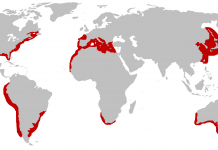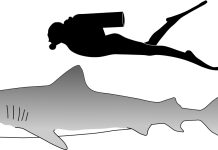The IUCN Red List of Threatened Species has listed the great whites as Vulnerable A2cd+3cd which mean they are no longer endangered species. However, according to a study in 2011, the number of great whites had decreased as low as 219 individuals (and so, regarded this species as ‘endangered’).
Are Great White Sharks Endangered?
Then again in recent times off the Eastern North Pacific Ocean, a team of researchers led by the University of Florida analyzed the population of great whites and came up with one of the most hopeful results. This latest study by Florida scientists has literally overturned this assumption because as per the team, there are nearly 2,000 great whites alive today, which is why it is now listed as ‘vulnerable’ on IUCN Red List.
The 2011 study underestimated the number of Great White Sharks in the oceans - and it should not be regarded as an endangered species – George Burgess, Director Florida Program for Shark Research
“[White shark] numbers are going up, and [great whites are] probably in a better situation than we’ve seen them in our lifetimes” – George Burgess
In South Africa, a team of researchers led by Sara Andreotti from the Stellenbosch University conducted a study spanning six years on the number of remaining white sharks. They came up with one of the most upsetting facts and concluded that only about 350 – 500 species of this shark are alive in the country. This rapidly decline in shark’s population is largely due to man-made causes like baits used to lure sharks, shark nets, trophy hunting and pollution leading to habitat degradation.
“We have come to the conclusion that South Africa’s white sharks faced a rapid decline in the last generation and that their numbers might already be too low to ensure their survival,” Ms Andreotti
Peddemors is perhaps the only researcher in Australia who has had any information about the population size of great whites in the country. He said that there were about 30,000 great whites in the country long before they had arrived on that continent.
Now the best estimate is less than 6,000
But it’s still going be a while before we start seeing … more rapid growth - Peddemors
Are Great White Sharks Endangered? - Video
Sources:
Fergusson, I., Compagno, L.J.V. & Marks, M. 2009. Carcharodon carcharias. The IUCN Red List of Threatened Species 2009: e.T3855A10133872.
Pawle, Fred. “Great white shark: endangered or just a danger to humans?”. THE AUSTRALIAN. June, 28, 2017.
“South Africa’s great white sharks ‘facing extinction’”. BBC News. July 20, 2016.
O’Callaghan, Jonathan. “Great White Sharks are not endangered: Study shows the number of predators is ten times higher than previously thought”. Mail Online. June, 17, 2014.













